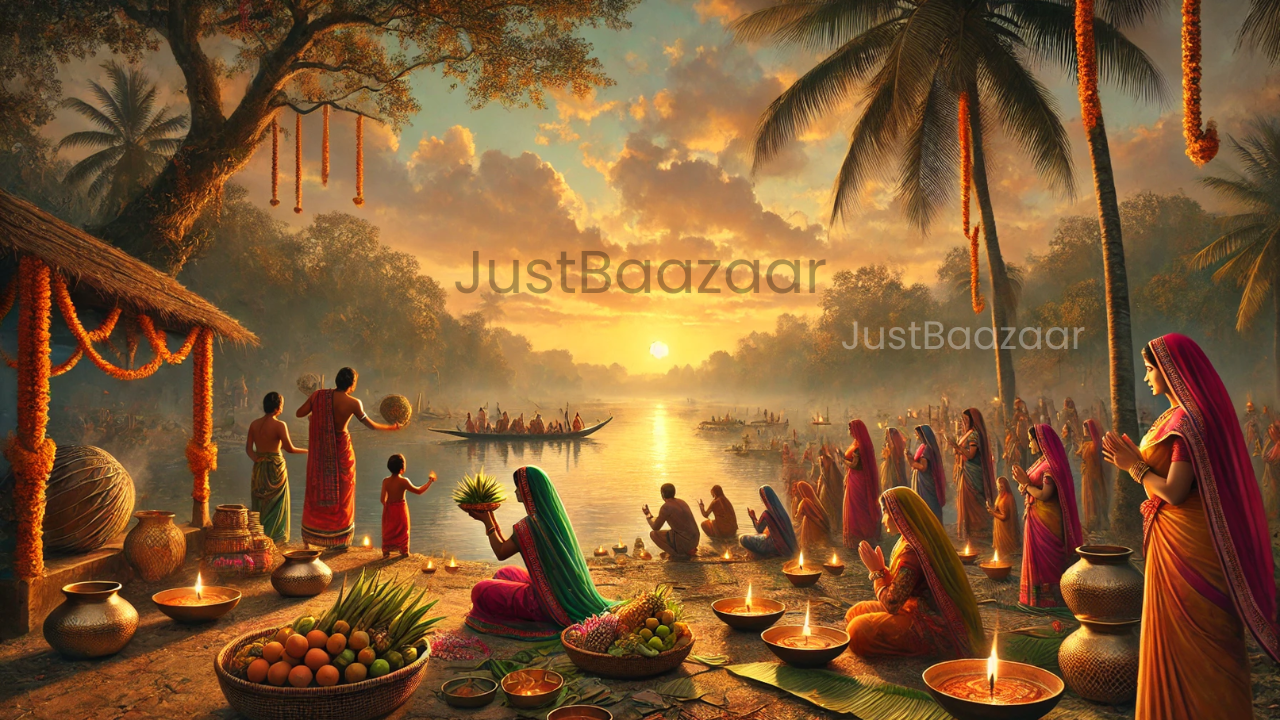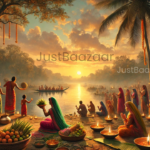Chhath Puja is one of the oldest Hindu festivals dedicated to worshiping Surya Dev (the Sun God) and Chhathi Maiya (Mother Goddess Shashthi). This ancient and revered festival is primarily celebrated in the states of Bihar, Jharkhand, Uttar Pradesh, and Nepal, where it holds deep cultural and spiritual significance. Chhath Puja is unique because it involves direct prayers to the sun, regarded as a life-sustaining force that nourishes all living beings. The festival spans four days and is marked by rigorous rituals, fasting, and heartfelt devotion.
Chhath Puja Story – Worship of Surya Dev 🌞

In this blog, we’ll take a closer look at the mythological story behind Chhath Puja, the significance of Sun worship, key rituals, and how people celebrate this festival to express gratitude and seek blessings.
🌞 The Story Behind Chhath Puja: Mythological Significance
The origins of Chhath Puja are deeply rooted in Hindu mythology, with several stories highlighting its significance:
1. The Story of Draupadi and the Pandavas
One prominent legend connects Chhath Puja to the epic Mahabharata, where Draupadi and the Pandavas performed this ritual to seek blessings from Surya Dev. The Pandavas, who had lost their kingdom in a game of dice, were advised by a sage to perform Chhath Puja to regain prosperity. Draupadi, known for her devotion, observed the rituals and fasted rigorously, seeking the Sun God’s blessings. As a result, they regained their kingdom, and their lives flourished once again.
2. The Legend of Lord Rama and Sita
According to another popular legend, after Lord Rama and Sita returned to Ayodhya after their 14-year exile, they observed Chhath Puja to express gratitude to the Sun God. It is believed that Sita observed a strict fast and performed rituals to seek blessings for a prosperous kingdom. This occasion also led to the continuation of the Chhath Puja tradition in the region of Ayodhya, marking the beginning of this divine practice.
3. The Story of Karna
Another notable story of Chhath Puja is associated with Karna, the son of Surya Dev and Kunti, from the Mahabharata. Karna, a great warrior, was a devout worshipper of Surya Dev. Every morning, he would stand in water, meditate, and offer Arghya (water offering) to the Sun. His devotion to the Sun God was unparalleled, and he is believed to have received immense strength and valor due to this practice. Karna’s reverence for Surya Dev laid the foundation for the water rituals seen in Chhath Puja today.
These stories emphasize the importance of devotion, purity, and gratitude, which form the essence of Chhath Puja celebrations.
🕉️ Why Worship the Sun? The Significance of Chhath Puja
Surya Dev is regarded as the source of life and energy, and worshiping him has both spiritual and scientific significance.
- Symbol of Vitality: Surya Dev represents the life-giving energy that sustains all forms of life on Earth. By worshiping the Sun, devotees express gratitude for light, warmth, and nourishment.
- Healing and Cleansing: The rituals of Chhath Puja are believed to have healing effects, as sun exposure during sunrise and sunset hours is known to boost immunity, improve mental clarity, and cleanse the body.
- Connection to Chhathi Maiya: Chhathi Maiya, the Mother Goddess, is considered the protector of children and family well-being. She blesses devotees with health, prosperity, and strength, making Chhath Puja a festival that strengthens family bonds and offers collective blessings.
In essence, Chhath Puja celebrates the spiritual and physical sustenance that the Sun provides, reflecting a harmonious relationship between humans and nature.
🌸 Rituals and Procedures of Chhath Puja: A Four-Day Spiritual Journey
Chhath Puja involves a series of rituals observed over four days, each with its own significance. These rituals require physical endurance, purity, and strict devotion.
🌅 Day 1: Nahay Khay (Bath and Eat)
- Ritual: Devotees start Chhath Puja by bathing in a holy river or water body, symbolizing purification. They clean their houses to create a sacred environment and prepare a vegetarian meal, typically made of rice, pumpkin, and pulses.
- Significance: This marks the beginning of the fasting period and is an act of cleansing both the body and the soul. The pure and simple food prepared on this day is offered to Surya Dev before consumption, symbolizing humility and devotion.
🌅 Day 2: Kharna (The Fasting)
- Ritual: Devotees observe a strict fast for the entire day, breaking it only after sunset. The fast is broken with a simple prasad (offering) of kheer (rice pudding), puris, and bananas. This meal is then shared with family and neighbors, promoting a sense of community.
- Significance: Kharna signifies the dedication and discipline of the devotee. The fast continues without water after this meal until the final day of Chhath Puja, symbolizing spiritual and physical resilience.
🌅 Day 3: Sandhya Arghya (Evening Offering)
- Ritual: On this day, devotees gather near rivers or ponds in the evening to offer prayers to the setting sun. They prepare offerings, including fruits, thekua (a sweet made of wheat flour and jaggery), and other traditional items, arranged in bamboo baskets.
- Significance: Offering Arghya to the setting sun is a way of expressing gratitude for the day’s light and blessings. This ritual signifies the cycle of life, acknowledging that each end is also a new beginning.
🌅 Day 4: Usha Arghya (Morning Offering)
- Ritual: On the final day, devotees return to the water source before dawn to offer Arghya to the rising sun. They stand in water, hold baskets of offerings above their heads, and pray for health, peace, and prosperity for their families.
- Breaking the Fast: After the morning prayers, devotees break their fast by consuming ginger and water, followed by distribution of the prasad among family and friends.
- Significance: The morning Arghya represents renewal and the hope of new beginnings. By offering water to the rising sun, devotees seek Surya Dev’s blessings for a fresh start, marking the end of Chhath Puja with positivity and grace.
🌸 Essential Offerings and Items Used in Chhath Puja
Each item used in Chhath Puja holds symbolic meaning and is essential to the rituals:
- Thekua: This sweet made from wheat flour and jaggery is a traditional offering symbolizing nourishment and purity.
- Sugarcane, Coconut, and Bananas: These natural items represent abundance and prosperity.
- Bamboo Baskets and Earthen Lamps: Bamboo baskets hold offerings and are considered sacred. Earthen lamps (diyas) signify purity and help illuminate the path of devotion.
- Traditional Saree: Women wear special sarees, typically in yellow or red, which are considered auspicious for performing the rituals.
🎉 Celebrating Chhath Puja: Community and Cultural Significance
Chhath Puja is both a personal and community celebration, bringing people together with devotion and festivity:
- Gatherings at Riverbanks: Large numbers of devotees gather at riverbanks or ponds, especially in regions like Patna, Varanasi, and Delhi, transforming these areas into sites of worship. Families and friends perform rituals together, creating an atmosphere of collective devotion.
- Folk Songs and Music: Traditional songs are sung throughout the festival, such as “Kanch Hi Bans Ke Bahangiya”, which invoke the blessings of Surya Dev and Chhathi Maiya. These songs carry a sense of nostalgia and strengthen cultural bonds.
- Eco-Friendly Celebrations: Devotees take special care to keep the environment clean during Chhath Puja by avoiding plastic and using natural materials like clay lamps, bamboo, and leaves. This respect for nature is an essential element of the festival.
The community aspect of Chhath Puja fosters unity and offers devotees an opportunity to celebrate and strengthen cultural ties.
🌞 The Spiritual and Environmental Essence of Chhath Puja
Chhath Puja is more than a festival; it’s an opportunity to reflect on our connection with nature and recognize the importance of sustainable and eco-friendly practices. By celebrating the Sun God and expressing gratitude for his energy, devotees learn to respect the natural elements that sustain life.
The festival represents:
- Harmony with Nature: Chhath Puja is a reminder of the balance between human life and nature, fostering reverence for the Earth’s resources.
- Resilience and Patience: The rigorous fasting and physical endurance required during Chhath Puja symbolize inner strength and spiritual growth.
- Gratitude and Renewal: The offerings to the Sun God at dusk and dawn are acts of gratitude and hope, symbolizing the continuous cycle of life.
Chhath Puja teaches us the timeless values of devotion, discipline, and environmental respect, making it a unique celebration that transcends generations and regional boundaries.
🌸 Conclusion: Celebrating Chhath Puja with Reverence and Unity
Chhath Puja is a testament to the enduring spirit of devotion and reverence for nature. It encourages devotees to embrace simplicity, practice discipline, and appreciate the natural elements that sustain life. From the mythical stories of Draupadi, Lord Rama, and Karna to the modern-day rituals, Chhath Puja continues to be a festival that bridges the past with the present.
As we offer prayers to Surya Dev and Chhathi Maiya, may we all be blessed with health, prosperity, and happiness. Whether celebrated by a riverbank or within one’s home, Chhath Puja brings light, positivity, and hope to all, uniting families and communities in a shared expression of gratitude and faith. 🌞
Related Posts on Chhath Puja:
- Chhath Puja Wishes in Sanskrit
- Chhath Puja Rituals
- Story of Chhath Puja
- Whatsapp Status on Chhath Puja
- Social Media Content Post Ideas on Chhath Puja
- Chhath Puja Wishes in Hindi with Emojis
- Chhath Puja Wishes in English with Emojis




